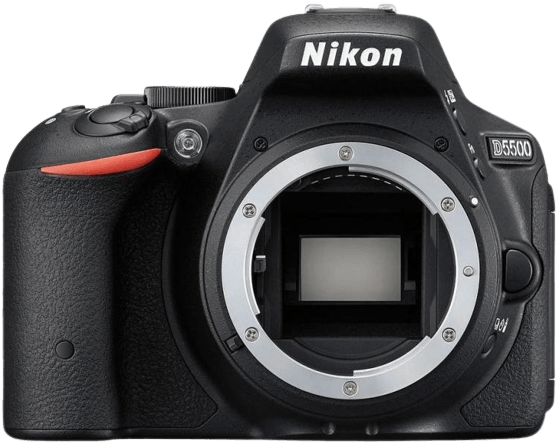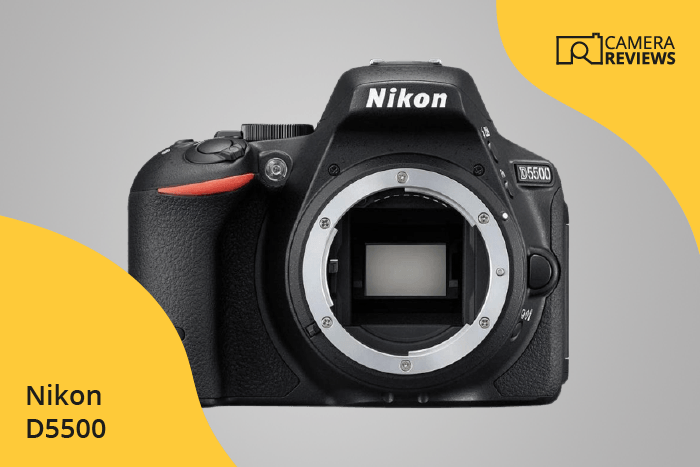Nikon D5500 Specs and Scores

The Nikon D5500 scores a 61/100, a decent rating for a DSLR camera released in 2015. Priced at $900 upon launch, this camera measures 124 x 97 x 70mm and weighs a mere 420g or 0.93lbs. Although it’s been a few years since its release, the D5500 still holds its own in the market with its compact size and lightweight design. This camera is a solid choice for those seeking a reliable and easy-to-carry DSLR.
Nikon D5500 Overview and Optics
The optics of the Nikon D5500 receives a score of 65/100. This camera features a 24.2-megapixel APS-C CMOS sensor, coupled with an Expeed 4 processor, resulting in a DXOMARK sensor score of 84. The camera has a shooting speed of 5 frames per second and supports a 3:2 aspect ratio.
The Nikon D5500 uses the Nikon F DX lens mount, which offers a wide range of compatible lenses. However, it lacks image stabilization, which can be a disadvantage for some users, especially when shooting in low light or with telephoto lenses. In today’s market, the Nikon D5500’s optics perform well for an entry-level DSLR, but it faces competition from newer models with improved features and performance.
Taking into account the specifications and performance, the Nikon D5500 offers reliable optics for photography enthusiasts. While it may not be the most advanced option available, it remains a solid choice for those seeking quality images and versatility in lens selection.
Nikon D5500 Video Performance
The Nikon D5500 receives a video score of 70/100, which reflects its capabilities in recording footage. This camera offers Full HD video resolution, with maximum dimensions of 1920 x 1080. Users can capture smooth action sequences, as the camera supports a maximum video frame rate of 60fps. Additionally, the D5500 includes built-in time-lapse functionality, enhancing its versatility for creative videography.
In the current market, the Nikon D5500 holds its ground as a reliable option for video recording. While 4K resolution is becoming increasingly popular, Full HD remains a widely accepted standard for many users. The 60fps frame rate and time-lapse features further add to this camera’s appeal for both amateur and professional videographers. The D5500 proves to be a solid choice for those seeking quality video capabilities and performance.
Nikon D5500 Features and Benefits
The Nikon D5500 features a score of 59/100, which reflects its capabilities and performance. With a 3.2-inch touchscreen and a screen resolution of 1037000 dots, this camera offers a clear and user-friendly interface. The flip screen adds versatility to shooting angles and compositions. However, the camera lacks GPS and Bluetooth capabilities, which may limit its appeal to some users.
In today’s market, the Nikon D5500 holds its ground with its touchscreen and flip screen features. The inclusion of Wi-Fi allows for easy sharing and transferring of images. Despite the absence of GPS and Bluetooth, this camera still delivers on essential features that cater to a variety of photographers.
The Nikon D5500 provides a solid performance, catering to users who prioritize user-friendly features and Wi-Fi connectivity. While it may not have all the bells and whistles of some competitors, it remains a reliable choice for many photography enthusiasts.
Nikon D5500 Storage and Battery
The Nikon D5500 receives a storage and battery score of 35/100. It has one memory card slot, which accepts SD, SDHC, and SDXC cards. In today’s market, this is a standard feature for DSLR cameras. The battery life of the Nikon D5500 is 820 shots, which is above average for its class. The camera uses an EN-EL14 battery type, but does not support USB charging.
Considering the storage and battery specifications, the Nikon D5500 provides adequate performance for casual photographers. However, more advanced users may find the single memory card slot limiting and the lack of USB charging inconvenient. Despite these drawbacks, the Nikon D5500 remains a reliable option for those seeking a DSLR camera with a decent battery life.
Nikon D5500 Alternatives
Do you want to know how the Nikon D5500 compares to its competitors? Have a look at the most popular comparisons for this camera below:
- Nikon D5500 vs D5600
- Nikon D5300 vs D5500
- Nikon D5500 vs D7100
- Nikon D3300 vs D5500
- Nikon D3500 vs D5500
- Canon EOS Rebel SL1 / 100D vs Nikon D5500
Nikon D5500 FAQ
Does the Nikon D5500 Have Built-in Image Stabilization?
The Nikon D5500 does not have built-in image stabilization. However, it supports lenses with Nikon’s Vibration Reduction (VR) technology, which helps to minimize camera shake.
Does the Nikon D5500 Support 4K Video Recording?
The Nikon D5500 does not support 4K video recording. Its maximum video resolution is Full HD 1080p at 60 frames per second.
What Size Sensor Does The Nikon D5500 Have?
The Nikon D5500 features an APS-C sized sensor, which is a 24.2-megapixel DX-format CMOS sensor, providing excellent image quality and low-light performance.
Does the Nikon D5500 Have a Dual Memory Card Slot?
The Nikon D5500 does not have a dual memory card slot. It has a single SD card slot that supports SD, SDHC, and SDXC cards.
Does the Nikon D5500 Have a Touch Screen?
Yes, the Nikon D5500 has a 3.2-inch vari-angle touch screen LCD, allowing for easy navigation, image review, and touch focus during live view shooting.
Does the Nikon D5500 Have Wi-Fi and Bluetooth?
The Nikon D5500 has built-in Wi-Fi for wireless image transfer and remote camera control, but it does not have Bluetooth connectivity.
Does the Nikon D5500 Have GPS?
The Nikon D5500 does not have built-in GPS functionality. However, you can use an external GPS device with the camera for geotagging purposes.
Is the Nikon D5500 Weather Sealed?
The Nikon D5500 is not weather sealed, so it is not designed to withstand harsh weather conditions or heavy rain without additional protection.
Does the Nikon D5500 Have a Built-in Flash?
Yes, the Nikon D5500 has a built-in pop-up flash, which is useful for fill-flash or low-light situations when an external flash is not available.

